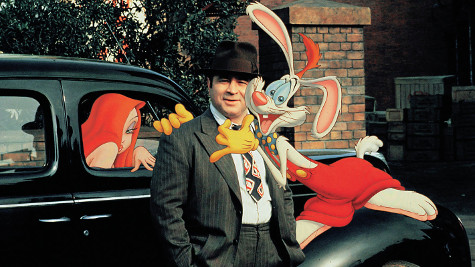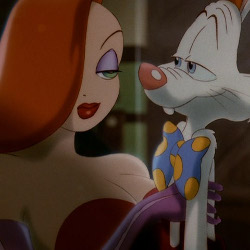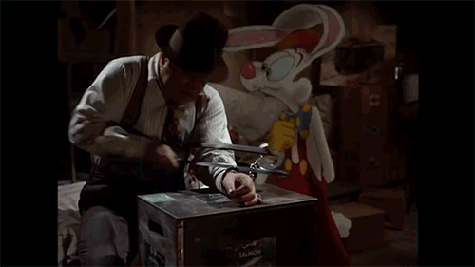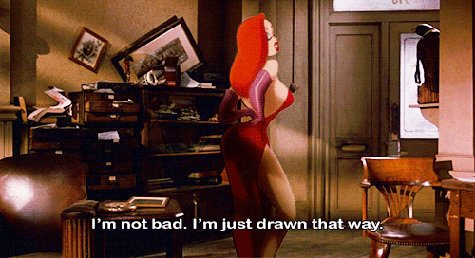
THE SUBGENRE: Cartoon noir.
THE HERO(ES): Private eye Eddie Valiant and the eponymous Toon.
THE VILLAIN: The mad Judge Doom.
THE LOVE INTEREST(S): Loyal “Girl Friday” Dolores and femme fatale Jessica.
THE SETTING: An alternate 1940's Hollywood.
1947, Hollywood. It's a familiar setting to any fan of noir.
This Hollywood, however, is different in one very significant way: there's a strange neighborhood on its fringe called Toontown. It's a Technicolor dream world with inhabitants that are downright animated…
Private eye Eddie Valiant (Bob Hoskins) has a chip on his shoulder the size of Gibraltar when it comes to Toons: those brightly-colored, two-dimensional characters that routinely smash through walls, break plates over their heads, and burst into frequent song and dance numbers—anything to make people laugh.
Eddie's not laughing, though. Years ago, a Toon dropped a piano on his partner and brother, Teddy, and ever since that terrible day, Detective Valiant has been a sour, curmudgeonly grump.
When R.K. Maroon (Alan Tilvern), the head of Maroon Cartoons, comes to Valiant with a job, Eddie's first instinct is to say no. He “doesn't do Toons.” Not anymore.
 A hundred dollars is nothing to sniff at in 1947, however, and in true gumshoe fashion, the hard-drinking, down-on-his-luck Eddie's got plenty of bills to pay. He reluctantly takes the case—seems that Maroon Cartoons star Roger Rabbit (Charles Fleischer) has been off his A-game thanks to the indiscretions of his sultry wife Jessica Rabbit (voiced by an uncredited Kathleen Turner).
A hundred dollars is nothing to sniff at in 1947, however, and in true gumshoe fashion, the hard-drinking, down-on-his-luck Eddie's got plenty of bills to pay. He reluctantly takes the case—seems that Maroon Cartoons star Roger Rabbit (Charles Fleischer) has been off his A-game thanks to the indiscretions of his sultry wife Jessica Rabbit (voiced by an uncredited Kathleen Turner).
Maroon wants Eddie to get photos of Jessica in the act so he can show Roger hard proof and convince him to kick his unfaithful wife to the curb.
When Eddie pulls through, though, and delivers some racy snapshots of Jessica playing patty-cake (literally—that's not an innuendo) with Marvin Acme (Stubby Kaye), the goofy genius behind Acme Products and the sole owner of Toontown, he couldn't predict what would follow.
By the next morning, Acme has been murdered via falling safe, so naturally the police are looking for a Toon. Given Roger's dramatic reaction to Eddie's pictures, it follows that the Maroon star must be the killer.
The unsettling Judge Doom (Christopher Lloyd) is determined to make an example of Roger, so he sends his weasel Toon henchmen to capture him so he can give him “The Dip.”
“Remember how they always thought there wasn't a way to kill a Toon? Well, Doom found a way. Turpentine, acetone, benzene. He calls it 'The Dip',” explains Lieutenant Santino (Richard LeParmentier).
At first, Eddie's plenty happy to leave the Acme murder to the police. His involvement with the case was over once he turned in those photos. But then, Roger turns up at his office professing his innocence, convinced he's being framed, and Eddie learns that Acme had a will leaving Toontown to the Toons—a will that's gone missing.
With Roger's life and the whole of Toontown hanging in the balance, Detective Valiant finds himself pulled back into the world of the Toons—whether he likes it or not.
Who Framed Roger Rabbit? is that rare breed of film: a childhood favorite that stands up to the test of time. In fact, it only improves over the years. During each re-watch, I'm staggered anew by how incredibly impressive this masterpiece is.
With the preponderance of CGI today, we take it for granted when physically impossible things play out across the big screen.
Roger Rabbit, however, was made in 1988—years before Jurassic Park would make the defining jump into integrating live action with CGI. The Toon characters we see interacting with the human actors and physical props aren't just men in green suits, Photoshopped out in post-production.
Every Toon was added in via hand-drawn animation. This means the film was turned into single frames during post so the animators could layer in the cartoons shot by shot. Primary director Richard Zemeckis had to be exceedingly careful to ensure the actors never missed their cues, otherwise the action and animation wouldn't line up correctly. At the same time, the animation director, Richard Williams, set out to break the three cardinal rules of mixing live action with animation:
- Move the camera as much as possible so the Toons don't look pasted on flat backgrounds.
- Use lighting and shadows to an extreme that was never before attempted.
- Have the Toons interact with real-world objects and people as much as possible.
One scene in particular, where Eddie and Roger are handcuffed together and Valiant is struggling to saw through the cuffs, encapsulates all of the challenges of the production. There are multiple things moving within the frame: the saw, the crate, and an overhead lamp (which Roger knocks into and is swinging the entire time, casting shifting light and shadow over the scene).
This requires actor Hoskins to follow a non-existent Roger as he moves while the animators have to keep track of a constantly changing light source. Did the light need to be moving at the time? No. But that extra effort pays off in dividends, reinforcing the belief that Roger is physically there and interacting with his environment. To this day, “bump the lamp” is a term Disney artists use when referring to going the extra mile.

The lamp scene also highlights a recurring theme in the story: Toons live by a different set of rules than humans. Roger can take his hand out of the cuff, but “only when it was funny,” suggesting they literally have to obey a code of comedy. They can obviously withstand a lot more physical trauma than humans—refrigerators dropped on their heads, bear traps to the hands, being set on fire, or smashed through walls, just for starters.
The Judge's infamous “Dip” (which is made of chemicals used to remove ink and paint from animation cells), however, dissolves them for good. Plus, he can administer “The Dip” to any Toon he wishes, without any trial or due process. Toons have to obey the laws set down by humans, but they can't benefit from any of them.
There's quite a lot of commentary on how Toons are exploited in Hollywood. Jessica works at The Ink and Paint Club, where Toons are only allowed in as performers and employees; the Club is strictly “humans only” in terms of clientele. She's also coerced into posing for those patty-cake photos because Maroon, who owns Roger's contract, threatens to destroy her husband's career if she doesn't.
Toons don't even own their own town. A human does. You can't help but feel for the animated characters as the story unfolds; Mickey Mouse might be the mayor of Toontown (as implied by one of Eddie's newspaper clippings), but he doesn't have much power, despite his iconic fame.
That's another unique aspect of Who Framed Roger Rabbit?. Though the film was a Disney production, Looney Tunes like Bugs Bunny, Porky Pig, and Tweety Bird are prominently featured. Droopy, Betty Boop, and Woody the Woodpecker are just a few of the other familiar faces who make appearances. This world is one where all animated characters live, not just those who belong to a single studio.
Animator Williams's goal was for the overall film to feel like a mixture of the great American cartoon styles: “Warner Brothers' Looney Tunes-type characters, Disney-quality animation, and Tex Avery-style humor.” The final product proves to be a resounding success on all counts.
Speaking of multiple influences, Roger's femme fatale wife, Jessica, was inspired by three noir favorites. She has the attitude and sex appeal of Rita Hayworth in Gilda, the peekaboo hairstyle of Veronica Lake, and “The Look” of Lauren Bacall.
She also gets the most quoted line from the whole movie:
JESSICA RABBIT: You don't know how hard it is being a woman looking the way I do.
EDDIE VALIANT: You don't know how hard it is being a man looking at a woman looking the way you do.
JESSICA RABBIT: I'm not bad. I'm just drawn that way.

The late, great Bob Hoskins is perhaps better known for his more serious and villainous roles; the Cockney actor excelled at tough guys. This will always be the performance I remember him for, though. His turn as the grumpy-gumshoe-with-a-heart-of-gold is an especially winning one.
Acting opposite thin air for most of the film, Hoskins proves he had impressive comedic timing. His Eddie is both a hardboiled noir hero and a straight man to a ridiculous partner; he even gets moments of romantic tenderness with longtime love and reliable Gal Friday Dolores (Joanna Cassidy).
Christopher Lloyd, everyone's favorite lovable mad scientist, plays the Judge as an obsessive and sadistic basket case. The scene where he gives an innocent clown shoe “The Dip” permanently scarred an entire generation.
According to IMDb, Tim Curry auditioned for the role but gave a performance that was “too terrifying.” Given how horrific Lloyd's Judge is, I shudder to imagine what Curry's must have been like.
Ultimately, what makes Who Framed Roger Rabbit? such a cinematic masterpiece worthy of frequent revisiting is the authenticity of its fantastical world. It's a pulpy, noir-tinged Hollywood where Eddie keeps a Maltese falcon-style bust by the door for his hat and his entire backstory is cleverly delivered via newspaper clippings on a dusty desk.
It's also a wild landscape where Daffy and Donald Duck perform at dueling pianos, Mickey Mouse and Bugs Bunny go sky-diving together, and it's totally believable that a hand-drawn vixen would seduce a human (or two) yet still be utterly faithful to her goofy rabbit husband.
The whole picture is utterly charming. If you haven't seen this yet, pick up a copy and prepare to be amazed by the artistry involved in this four-time Oscar winner. If you have fond childhood memories, settle in for a re-watch free of fear: it's even better than you remember.
Angie Barry wrote her thesis on the socio-political commentary in zombie films. Meeting George Romero is high on her bucket list, and she has spent hours putting together her zombie apocalypse survival plan. She also writes horror and fantasy in her spare time, and watches far too much Doctor Who. Come find the angie bee at Tumblr.

Eddie Valiant and R.K. Maroon his studio Eddie take some pictures
63 Kates Street
You asked them please